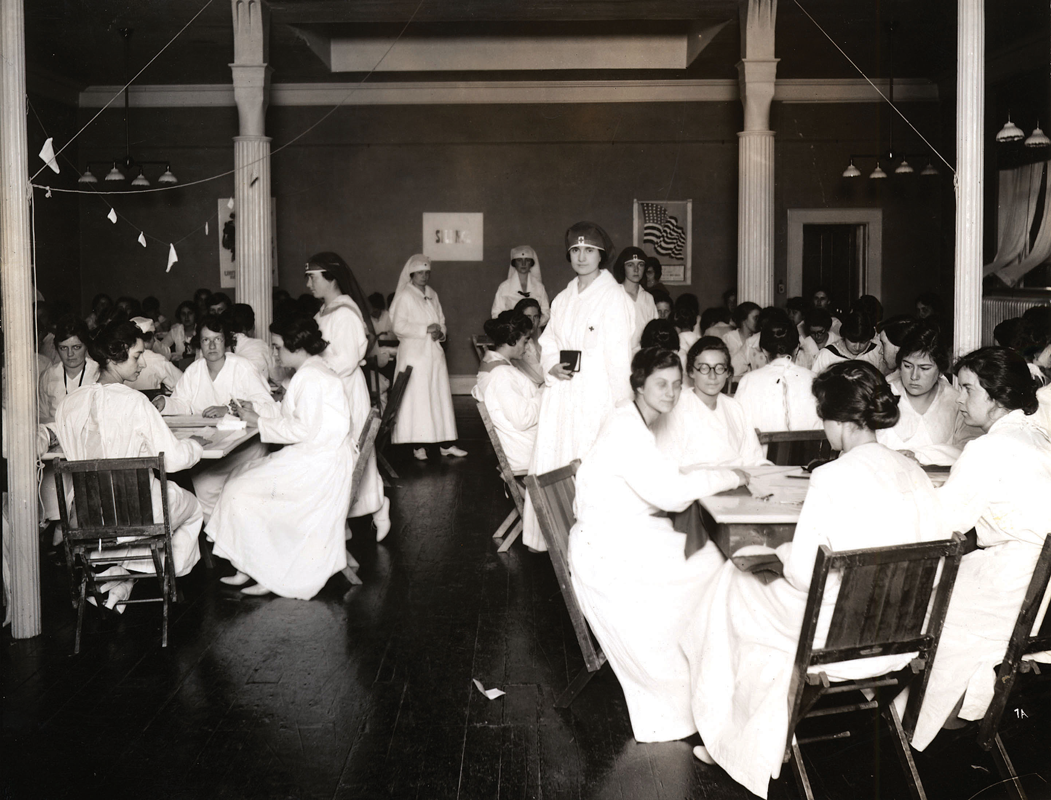Vassar and the "Great War"

As the world paused this summer to observe the centennial of what was known at the time as the Great War, one of the larger plaques on the Vassar campus, placed at the base of the stairs that lead to the upper floors of the Chapel tower, bore silent witness to Vassar’s own connections to World War I. Embossed with three flags, the bronze plaque carries the inscription, “In memory of the Vassar alumnae who gave their lives in service overseas during the World War,” and continues with the names of four of the college’s graduates: Dorothea Gay 1911, a YMCA worker who died less than two months after arriving in France of “pneumonia brought on by exposure and constant work in the Bordeaux canteen”; Ruth Cutler 1912, a social worker who succumbed to the same disease a few weeks into her service in Paris; Amabel Scharff Roberts 1913, a trained nurse who lost her life to a septic infection at a British field hospital not far from the front; and Gertrude Crissey Valentine 1912, another YMCA canteen worker killed in an auto accident a few days after writing a breezy last letter reporting her adventures in France, an account that was reprinted in the Miscellany News with the announcement of her death.
As the wartime issues of the Misc make clear, the impact of the conflict was felt on campus immediately following America’s entry into the war on April 6, 1917. A lively spirit of patriotism—sometimes leavened by concern for achieving lasting peace—suffused the student newspaper, with announcements of “preparedness” courses that ranged from First Aid and Surgical Dressing to Design for War Posters, from Motor Repair to an increased emphasis on foreign languages. Vassar students formed committees, donated to Liberty Loans and the National Students Fund, and knit socks and sweaters for the troops, prompting indignant letters (and equally indignant responses thereto) about the appropriateness of knitting during lectures and at chapel. As the war progressed, students were reminded that “our men in France are crazy for letters from home” and were urged to meet the deadline for sending Christmas packages overseas.
The Misc did not shy away from sobering reminders of the cost of the national effort; Roberts’s death, the first among the graduates, was simply headlined “Gold Star Service,” an allusion to the tradition of families who have lost someone in wartime displaying a banner with a gold star. And the wartime achievements of alumnae increasingly drew attention, especially the postwar work of the Vassar Relief Unit, which was recruited from Vassar alumnae and equipped through the donations of the college’s students, faculty, alumnae, and friends. Headed by Margaret Lambie 1907, the unit was created to help bring relief to Verdun, a city that had been shattered by perhaps the most famous battle of the First World War. The women of the unit purchased a camionette (small truck) that was sent to nearby villages to collect milk from farmers; that milk was pasteurized and modified, then distributed free of charge at the unit’s milk station, the Goutte de Lait, providing the local children with some badly needed nutrition.
The members of the Vassar Relief Unit were among an estimated 200 of the college’s graduates who served overseas during World War I and its immediate aftermath. Echoing the bronze plaque at the base of Vassar’s Chapel tower, a marble plaque was placed by the French in Verdun as a tribute to all of these women. Also in their honor, on Armistice Day, 1920, the French government presented Vassar with a most unusual gift—a 40-ton St. Chamond tank—which sat on Joss Beach for two decades, and earned its own storied place in Vassar’s history as a spot for illicit rendezvous, until it was cut up for scrap metal during the next world war.
Lance Ringel is a senior writer at Vassar. His novel Flower of Iowa, set in World War I, was published earlier this year.
